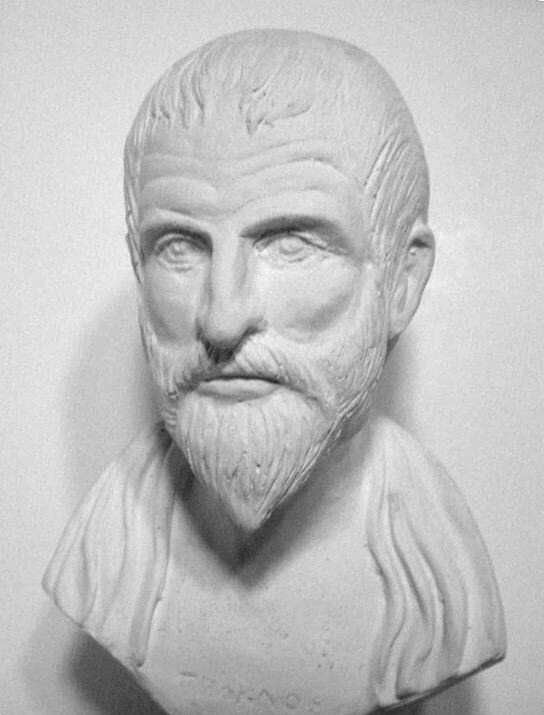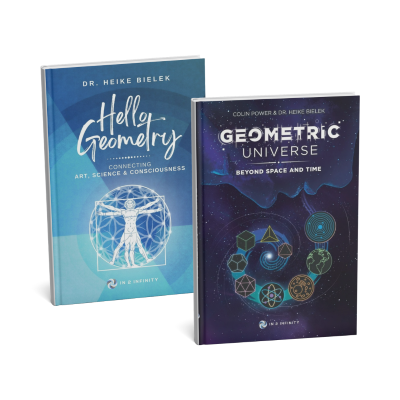Introduction
Geometry can be defined as a quantitative and qualitative study of space and forms. The most fundamental attributes about space/form include shape and size. Geometry is a deductive system. This means there is a logical development and a few simple, fundamental principles. But before moving on to the content of geometry, it is important to understand a little about the nature of geometry and something about its course of historical development.
Geometry, in a fundamental sense, is the evolution of elementary ideas about shapes and forms that arise out of our exposure to the physical and natural world. In our interactions with our environment, we encounter physical shapes, such as rocks, mountains, trees, sticks and all kinds of things which though are different and diverse but can still be organized by patterns into groups and classes. Some are ‘straight-ish’ others are ‘round-ish’ and so on. Developing from such primitive ideas, geometry grew to become the “Art of measuring” out of practical necessities. Geometry may have its roots in our curiosity and attempt to better understand these rudimentary ideas, but the geometry that we know today didn’t start developing until someone separated the physical world from the mental.
History
Geometry started taking its modern form when the human mind started “abstraction” of perfect mental objects out of the imperfect physical objects. In the mental world, we can think of a perfectly straight line instead of having to deal with an imperfect, approximately straight-ish physical stick. In the same way, a random mountain terrain may provide the idea about a perfect triangular abstract form, sun or moon’s shape resulting in the idea of a perfect abstract circle and so on.
The key thing to understand is that in geometry we don’t deal with worldly imperfections, but instead our objects of study are perfect mental constructs which have evolved from a process of abstraction out of physical and natural forms. The next important stage in the evolution of geometry was when the Greeks started learning geometry from the Egyptians. Where under the Egyptians, geometry remained more like a collection of random results, it developed into what we know today as the “axiomatic system” under the Greeks.
Thales and Pythagoras were among the first prominent figures who learnt geometry from the Greeks and then went on starting their own schools in Greece. One of the most important features of the schools of both Pythagoras and Thales was their insistence that mathematical results be justified or proved true. This focus on proofs required a method of reasoning and argument that was precise and logical. This method which had its origins with Pythagoras and Thales then culminated with the “The Elements” by Euclid in about 300 BC. The method has become known as the Axiomatic Method.”
Principles
The axiomatic method is based on a system of deductive reasoning. In a deductive system, statements used in an argument must be derived, or based upon, prior statements used in the argument. These prior statements must themselves be derived from even earlier statements, and so on. A postulate or axiom is a logical statement about terms that is accepted as true without proof. Starting from a base of defined terms and agreed upon axioms, we can define other terms and use our axioms to argue the truth of other statements. In an axiomatic system, it does not matter what the terms represent. The only thing that matters is how the terms are related to each other. By giving the terms a specific meaning, we are creating an interpretation of the axiomatic system.

Greek geometer Proclus (411 – 485 AD) believed that by training our minds in the most careful and rigorous forms of reasoning abstracted from the real world, we are preparing our minds for the harder task of reasoning about things that we cannot perceive. For Proclus, this type of reasoning arouses our innate knowledge, awakens our intellect, purges our understanding, brings to light the concepts that belong essentially to us, takes away the forgetfulness and ignorance that we have from birth, and sets us free from the bonds of unreason.
The system of deductive reasoning was put into definitive form by Euclid around 300 BC in his 13-volume work Elements. Euclid was a scholar at one of the great schools of the ancient world, the Museum of Alexandria, and was noted for his lucid exposition and great teaching ability. The Elements were so comprehensive in scope that this work superseded all previous textbooks in geometry and persisted as the standard textbook for the next two millennia. What makes Euclid’s exposition so important is its clarity. Euclid begins with a few definitions, a few rules of logic, and ten statements that are axiomatic in nature. Euclid divides these into geometric statements, which he calls postulates and common notions.

Euclid's Definitions
The exposition of every subject requires its own vocabulary, with precise meaning attached to each term. Euclid provides clear and concise definitions for the terms that he uses. Some of the definitions in the spirit of Euclid are as follows:
- A point is that which has no part.
- A line is breadthless length.
- The ends of a line are points.
- A straight line is a line which lies evenly with the points on itself.
- A surface is that which has length and breadth only.
Euclid provides many more definitions but those will be discussed in later sections. For now let’s define four more objects, rectilinear figures, equilateral triangle, right angle and parallel lines. These will be used later in this section.
- Rectilinear figures are those which are contained by straight lines, trilateral figures being those contained by three, quadrilateral those contained by four, and multilateral those contained by more than four straight lines.
- Of trilateral figures, an equilateral triangle is that which has its three sides equal, an isosceles triangle that has two of its sides alone equal, and a scalene triangle that has its three sides unequal.
- When a straight line standing on a straight line makes the adjacent angles equal to one another, each of the equal angles is right, and the straight line standing on the other is called a perpendicular to that on which it stands.
- Parallel straight lines are straight lines which, being in the same plane and being produced indefinitely in both directions, do not meet one another in either direction.
Axioms can be understood as readily agreed upon or self-evident truths which don’t need to be proved through logical or deductive reasoning but are used to logically deduce everything else. Further results about the nature of geometric space, its objects and properties are derived by employing logical and deductive reasoning using these axioms as foundation.
Common Notions
Common notions refer to more universal statements about general logical systems.
- Things which are equal to the same thing are also equal to one another.
- If equals are added to equals, the wholes are equal.
- If equals are subtracted from equals, then the remainders are equal.
- Things which coincide with one another are equal to one another.
- The whole is greater than the part.
Postulates
Postulates are about the specific objects under study.
- To draw a straight line from any point to any point.
- To produce a finite straight line continuously in a straight line.
- To describe a circle with any center and radius.
- That all right angles equal one another.
- That, if a straight line falling on two straight lines makes the interior angles on the same side less than two right angles, the two straight lines, if produced indefinitely, meet on that side on which are the angles less than the two right angles.
The first three postulates provide the theoretical foundation for constructing figures based on a hypothetically perfect straightedge and compass. We will consider each of these in more detail, taking care to point out exactly what they say and what they do not say.
- The first postulate states that given two points, one can construct a line connecting these points. Note, however, that it does not say that there is only one line joining two points.
- The second postulate says that finite portions of lines (i.e., segments) can be extended. It does not say that lines are infinite in extent.
- The third postulate says that given a point and a distance from that point, we can construct a circle with the point as center and the distance as radius. Here, again, the postulate does not say anything about other properties of circles.
- The fourth postulate is obvious and follows directly from the very definition of a right angle.
The fifth postulate (also known as the parallel postulate) on the other hand has given some concerns to mathematicians and needs to be discussed separately. Euclid’s fifth postulate, also called the parallel postulate, remained a subject of scrutiny from mathematicians for over two millennia. For two thousand years, many attempts were made to prove the parallel postulate using Euclid’s first four postulates. The main reason that such a proof was so highly sought after was that, unlike the first four postulates, the parallel postulate is not self-evident. If the order the postulates were listed in the Elements is significant, it indicates that Euclid included this postulate only when he realised he could not prove it or proceed without it.
the 5th POSTULATE
The first three postulates describe constructions. Today we would probably reinterpret them as statements about the existence of certain objects (namely lines, segments, and circles). The fourth provides a way to compare angles. As for the fifth, it needs to be said that Euclid’s fifth postulate does not look like the other four. It is considerably longer and more complicated than the others. For that reason, generations of geometers after Euclid hoped that the fifth might actually be provable-that it could be taken as a theorem rather than a postulate.
Many attempts were made to prove the fifth postulate from the other four, many of them being accepted as proof for long periods until the mistake was found. Invariably the mistake was assuming some ‘obvious’ property which turned out to be equivalent to the fifth postulate. Now we know that it is impossible to derive the Parallel Postulate from the first four. The next section discusses some of these equivalent statements of the parallel postulate, which resulted from the attempts of generations of mathematicians trying to redefine the fifth postulate.
EQUIVALENT PROPERTIES OF PARALLEL POSTULATE
The best known equivalent of Euclid’s parallel postulate, is Playfair’s axiom, named after the Scottish mathematician John Playfair, which states:
“In a plane, given a line and a point not on it, at most one line parallel to the given line can be drawn through the point”
Although known from the time of Proclus, this became known as Playfair’s Axiom after John Playfair wrote a famous commentary on Euclid in 1795 in which he proposed replacing Euclid’s fifth postulate by his own axiom.
Many other statements equivalent to the parallel postulate have been suggested, some of them appearing at first to be unrelated to parallelism, and some seeming so self-evident that they were unconsciously assumed by people who claimed to have proven the parallel postulate from Euclid’s other postulates. These equivalent statements include:
- The sum of the angles in every triangle is 180° (triangle postulate).
- There exists a triangle whose angles add up to 180°.
- The sum of the angles is the same for every triangle.
- There exists a pair of similar non-congruent triangles.
- There exists a pair of straight lines everywhere, equidistant from one another.
- For any three noncollinear points, there exists a circle passing through them.
- If three angles of a quadrilateral are right angles, then the fourth angle is also a right angle.
- If a straight line intersects one of two parallels, it will intersect the other.
- Straight lines parallel to a third line are parallel to each other.
- Two straight lines that intersect one another cannot be parallel to a third line.
Non-Euclidean Geometries
Non-Euclidean geometry arises by replacing the parallel postulate with an alternative. In doing so, one obtains hyperbolic geometry and elliptic geometry, the traditional non-Euclidean geometries.
A simple way to describe the differences between these geometries is to consider two straight lines indefinitely extended in a two-dimensional plane that are both perpendicular to a third line (in the same plane):
- In Euclidean geometry, the lines remain at a constant distance from each other (meaning that a line drawn perpendicular to one line at any point will intersect the other line and the length of the line segment joining the points of intersection remains constant) and are known as parallels.
- In hyperbolic geometry, they “curve away” from each other, increasing in distance as one moves further from the points of intersection with the common perpendicular; these lines are often called ultra parallels.
- In elliptic geometry, the lines “curve toward” each other and intersect.
Neutral Geometry
The Euclidean geometry that can be developed from the parallel axiom is radically different from the hyperbolic geometry that can be developed from its negation. Even so, Euclidean and non-Euclidean geometry are not opposites. As different as they are in many ways, they share many basic characteristics. Neutral geometry (or absolute geometry in) is the study of those commonalities. To do that, they had to work in a geometry which neither assumes nor negates it. This geometry is now called neutral geometry.
Projective Geometry
Projective geometry is a non – metric (independent of the concept of distance) system of geometry which studies geometric properties that are invariant under geometric transformations. A projective space is different from the Euclidean space in a fundamental sense that in a projective space parallel lines meet at a point on what’s called a horizon (representative of the point at infinity) while in the case of Euclidean space the parallel lines never meet. Projective geometry can also be seen as a geometry of constructions with a straight – edge alone. Since projective geometry excludes compass constructions, there are no circles, no angles, no measurements and no parallels.
Final Thoughts
A plethora of geometries exist in modern times that deviate from the classical Euclidean geometry in many different ways. But Euclid’s geometry still forms the core of the geometric education and is the indispensable stepping stone for anyone interested in learning geometry. In the next section, we will start exploring the most rudimentary elements and results of geometry.
Explore more
geometric principles
This post is part of our Guide to Euclidean Geometry. You can explore more or return to the index page to follow the series in sequential order.
Up Next
Polyhedra I (Prisms and Pyramids)
Welcome, to this online guide to Euclidean Geometry, produced by In2infinity, and written by Sunil…





